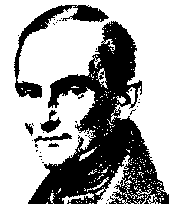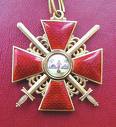Martin Wilhelm von Mandt 1799 - 1858
August 06, 2009
 Martin
Wilhelm von
Mandt
1799 (1800) -
1858
was a German orthodox physician and a Professor at
Greifswald,
who converted to
homeopathy
and developed the Atomist System of medicine.
Martin
Wilhelm von
Mandt
1799 (1800) -
1858
was a German orthodox physician and a Professor at
Greifswald,
who converted to
homeopathy
and developed the Atomist System of medicine.
Mandt was awarded
the  Order of St.
Anna,
Order of St.
Anna,
Mandt was the homeopathic physician of Peter von Meyendorff and Robert Alexander Schumann, and Helene of Russia and Princess Charlotte of Prussia.
Mandt was also the Court Physician of Tsar Nicholas I, who ordered the translation of Martin Mandt’s pamphlet on homeopathy translated into Russian, and he had it distributed to all his hospital management administrators and staff physicians.
Tsar Nicholas I also established an Exemplar hospital with Martin Mandt in post, and this hospital functioned from 1853 – 1856, and Tsar Nicholas I also ordered that all medicine chests in the hospital be replaced by Mandt’s medicine chests.
’… *. Dr Mandt__, the physician to the Czar Nicolas, is a homeopath: the vigorous Men Monarchs of Europe are beginning to find out what benefits the new medicine procures for those who adopt it… *(Swedenborg Archive K124 [b] Letter dated 13.3.1855 from Garth Wilkinson to James John Wilkinson senior).’ James John Garth Wilkinson
From http://www.homeoint.org/books4/kotok/2300.htm ‘… Mandt arrived in Russia in the late 1830s. Describing those events, Carl Bojanus wrote: ”Mandt’s treatment during the epidemic of cholera in 1848, and later similar treatment in some military hospitals, had had such a success that Tsar Nicholas I, who had never been indifferent to the treatment of soldiers, became interested in this method.
He ordered the translation of Mandt’s brochure, in which Mandt’s theory was exposed, from German into Russian, and had it distributed to the management of all the military hospitals as well as to all the staff physicians. Tsar Nicholas I’s will was carried out.
However, for the zealots of the purity of medical education the ‘atomistic doctrine’ and homeopathy were the same, hence it goes without saying that this method could provoke neither approval nor encouragement […].
As soon as the Emperor died [in 1855], both the authority of Mandt and his method of treatment disappeared. Moreover, the death of Tsar Nicholas I was ascribed to Mandt’s poor treatment… ”
Some orthodox homeopaths were entirely unconvinced that Mandt’s atomist system of treatment was Hahnemanian homeopathy, and they were also scathing about the two remedy method employed by Arthur Ernst Lutze. However, there is little doubt that both Mandt and Arthur Ernst Lutze were homeopaths by ‘any other name’, as many of Mandt’s contemporaries acknowledged.
Mandt caused quite a controversy amongst homeopaths in his day for his ‘half breed’ homeopathy, and his method of prescribing two or three homeopathic remedies together.
This debate was fanned into flame as opponents of homeopathy used this controversy to attack homeopathy and to try and split the homeopathic camp. Mandt was equally unpopular with some Russian orthodox physicians and most of the Russian Court, who were upset that Tsar Nicholas I also consulted Christian Theodore Herrmann, Simon Nicolaievitch von Korsakoff, and Carl Bernhard von Trinius, and authorised the homeopathic treatment of his army, having first observed such treatment of cadets at the Naval College in Oranienbaum by O F Scherring.
These lies were also possibly an attempt to obscure the fact that cause of Tsar Nicholas I’s death is unclear, though many believed he poisoned himself after learning of Russia’s defeat at Evpatoria during the Crimean War.
Mandt actually treated Tsar Nicholas I for a pneumonia and possibly ‘the grippe’ contracted whilst Tsar Nicholas I was on campaign, though Tsar Nicholas I ignored Mandt’s advice and the winter chill.
As he promised Tsar Nicholas I, Mandt was truthful with the dying Tsar, informing him that his lung had collapsed and that he was dying, thus enabling Tsar Nicholas I to put his house and his records in order, and for sad farewells to be said. The Tsarina, Princess Charlotte of Prussia, was also a patient of Mandt, and also ill at the time, and a smooth passage to Tsar Alexander II, who stood at his father’s bedside to the last, was at least politically safe in such troubled times.
The spread of homeopathy in Russia was so alarming to opponents of homeopathy, they conducted a campaign of lies to try and influence Tsar Alexander II, which rebounded on them and spread homeopathy throught Russia even more.
Mandt left Russia in the spring 1856 for Germany, where he died two years later, causing yet another storm of mistruths from the opponents of homeopathy, who spread even more lies to damage his name and reputation.
In 1848, Mandt treated a cholera epidemic with homeopathy, and he also worked in the Military hospitals, again treating soldiers.
From 1813, he attended the Gymnasium in Duren, and from his father he obtained some knowledge of anatomy and field dressings by the end of the year 1816, the Professor and Chief Doctor CF Grafe of Dusseldorf allowed him to treat wounded soldiers.
He remained at this task during the year 1817, and then he was sent to Thionville for his obligatory Prussian military service. At the beginning of 1819, he was in Berlin with a local Regiment, where he could attend the University at the suggestion of Karl Asmund Rudolphi, whose special favor he enjoyed.
With government support from March to September 1821, he moved from Hamburg to the vessel “Blucher”, under the English Captain John Rose, for a trip to Greenland and Spitsbergen in the capacity of a ship’s doctor, where he undertook zoological research in the Arctic.
On his return, he became an assistant at the anatomical museum. In the winter of 1823, he passed his medical state examination. In February 1825, he was appointed District Physician in Kustrin. His published some work in the literature of his time. Kuftriner has recorded some articles in Retrieves’s Magazine (vol. 19, 22, 1825, 1826) and a Practical presentation of major infectious epidemics and epizootic diseases, their importance for the police medicinische , published in Berlin.
In 1829, he was employed by the Faculty in Greifswalder by his predecessor, Friedrich August Berndt, and he was then appoited to Professor of Surgery. He settled in the spring of 1830, in Greifswald, and he accepted 7 students. Mandt then became the physician at the Surgical Ophthalmic Clinic, and began lecturing at a School of Surgery. He was appointed Director of that School, and accepted students from the Faculty, and in a very short time he had 40 pupils.
In 1832, he made a 6 month scientific journey through Germany, Italy, France and England, and produced a very detailed report, mentioning especially the lunatic institutions to which he had paid particular attention. Mandt published several treatises, including Findings of History, as well as a book on a new surgical method, a book on parasites, The Goitre, A History of the Theiler lntestini rectj as a university program, A Brief outline of the history of surgery until the beginning.
By 1835, after Rust’s recommendation to Helene of Russia, Mandt accompanied Helene on a trip to the baths and he was appointed as her personal physician in St. Petersburg. The Prussian government granted his extended leave to fulfil this post on a temporary basis, but in 1838, this position became permanent. Mandt was thus appointed personal physician to Tsar Nicholas I in recognition of his important service to Helene.
In 1840, Mandt was confirmed as the personal physician to the Royal Court, and was awarded the Russian military rank and title of Real Staatsrathes, such that the personalities of the Court and the hostility that many of his publications had caused were mitigated, although with great difficulty, but his firm held in the full confidence of Tsar Nicholas I he now possessed. Mandt was a great favourite of Tsar Nicholas I and the Tsarina.
In the same year, Mandt was permitted to open a private surgical clinic at the Imperial Academy of Medicine, and to teach and lecture there. In this clinic, Mandt was able to improve both the physical and chemical diagnostic techniques, and to improve the teaching of pathological anatomy, and thereby to educate a number of good students.
Mandt established an extensive private practice in the Royal Court and in the city, and by 1849, he had published works related to cholera, The Spinal cord and intestinal mucosa and their relationships to the cholera, and The Colour of the intestinal mucosa in cholera and typhoid corpses.
Mandt did meet some difficulties, for example pursuading the Tsarina to accept a longer stay in a southern climate, opposing the will of Tsar Nicholas I and pursuading him to accept a trip to Italy, and to establish a winter residence in Palermo.
By 1850, Mandt had received many awards and Orders, including the highest, that of a secret Rath, which he enjoyed until the death of Tsar Nicholas I in 1855.
On November 20th 1858, after being affected by a paralysis, Mandt died.
Mandt’s characteristics should be emphasized that his great talents, combined with an engaging, skilled care and rare strength of character enabled him to have a grande career. It is to his glory that he left so many elements of his science to posterity. His German nationality was always a great part of his personality.
In medicine, he was eclectic and empiricist in the best sense of the word. Mandt embraced homeopathy, and he also published widely on zoology, where he named three Thierstein Species in his name, namely a bird from Greenland, and two other animal species. (see Lopholithodes mandtii)
Mandt submitted cases and articles to various homeopathic publications, and he also wrote Observationes in historiam naturalem et anatomiam comparatam in itinere Groenlandico factae, Practische darstellung der wichtigsten ansteckenden Epidemieen und Epizootieen in ihrer bedeutung für die medicinische Polizei, Rückenmark und Darmschleimhaut und ihr Verhältniss zur Cholera, Kurzer Umriss der Geschichte der Chirurgie bis zum Anfange unseres Jahrhunderts: nebst einem Blick auf die Bildung der Wundärzte in England, Färbung der Darmschleimhaut in Cholera- und Typhusleichen: dargestellt in 15 colorierten Tafeln nebst erläuterndem Texte, Ein deutscher Arzt am Hofe Kaiser Nikolaus I,